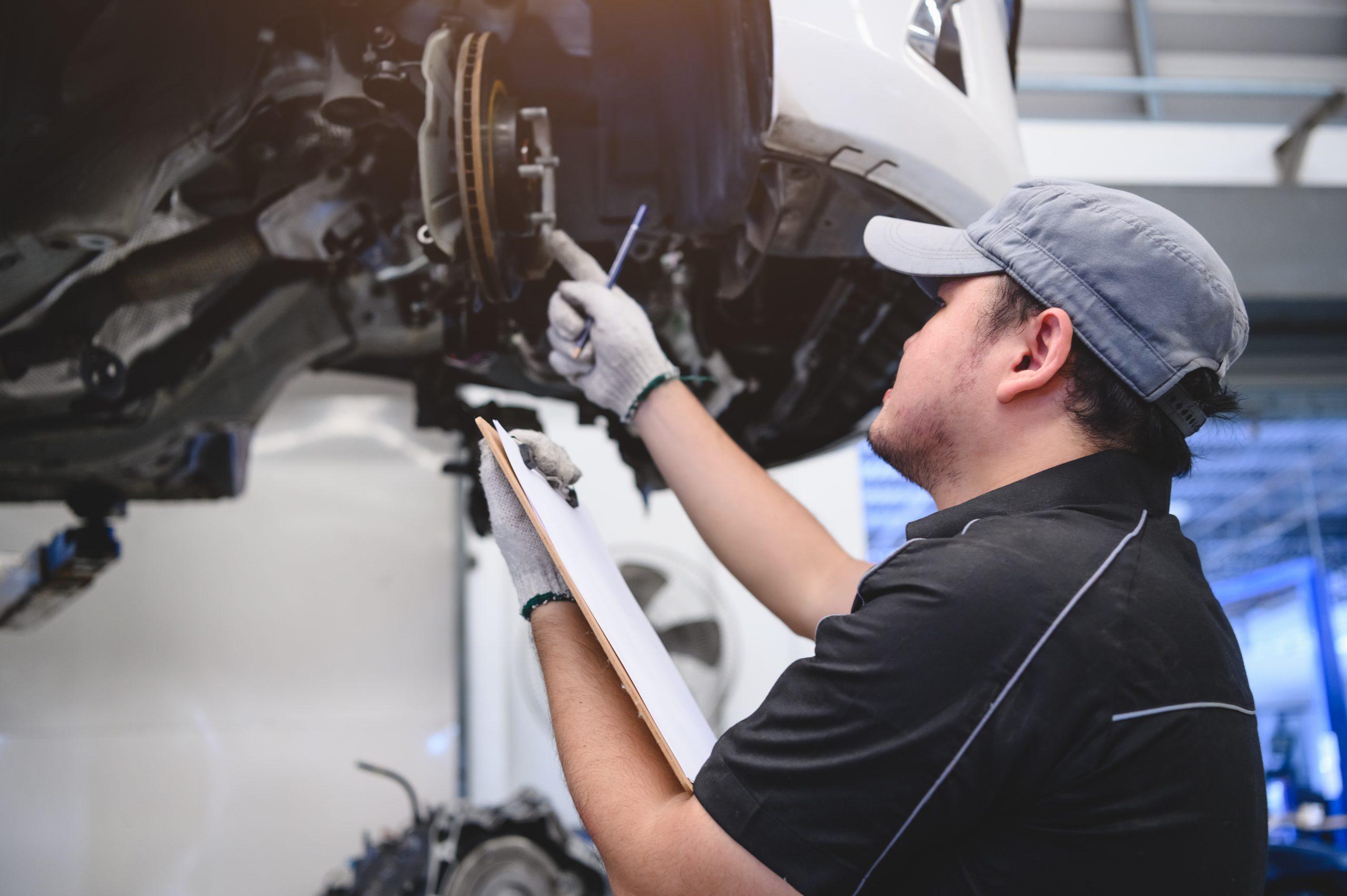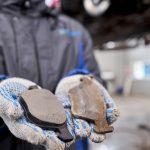
How to Conduct a Thorough Brake Safety Inspection
- Harbor Brakes
- December 8, 2023
- Brakes
- brake disc, brake fluids, brake maintenance, brake pads, brake rotors, brake service, brakes, pads, rotors
A thorough brake safety inspection is crucial for ensuring your safety on the road. By following a comprehensive checklist, you can identify any potential issues with the braking system and take the necessary steps to address them.
This includes conducting a test drive to check for abnormal noises or vibrations, inspecting the tires and suspension system, checking for leaks or damage to hoses and steel lines, examining the brake master cylinder and calipers for leaks, inspecting the rotors and drums for damage, and replacing brake pads if necessary.
It’s important to remember that regular maintenance and proper care of the braking system can prevent excessive wear and extend the lifespan of the components.
Key Takeaways:
- A thorough brake safety inspection is essential for your safety on the road.
- Follow a comprehensive checklist to identify potential issues with the braking system.
- Conduct a test drive to check for abnormal noises or vibrations.
- Inspect the tires, suspension system, hoses, steel lines, brake master cylinder, calipers, rotors, and drums.
- Replace brake pads if necessary.
Importance of Brake Maintenance and Service

Brake maintenance and service are essential for ensuring the continued safety and reliability of your vehicle’s braking system. Neglecting regular inspections and necessary repairs can lead to issues such as decreased stopping power, increased braking distances, and potential brake failure. By performing routine brake system inspections, you can detect and address concerns early on, preventing costly repairs and ensuring optimal performance. It’s important to remember that maintaining your brakes is not only important for your own safety but also for the safety of others on the road.
Regular brake maintenance includes checking the brake fluid level and condition, inspecting the brake pads and rotors for wear, and ensuring that all brake system components are in good working order. Brake service may involve replacing worn brake pads, resurfacing or replacing brake rotors, and addressing any issues with calipers, hoses, or other brake system parts. By keeping up with regular maintenance and addressing any concerns promptly, you can ensure that your brakes are functioning properly and provide maximum safety.
Benefits of Regular Brake Maintenance and Service:
- Enhanced brake performance and responsiveness
- Improved safety for you and other road users
- Prevention of costly brake system repairs
- Extended lifespan of brake components
- Peace of mind knowing that your brakes are in good working condition
Remember, it’s important to consult a qualified technician to perform brake maintenance and service. They have the expertise and knowledge to properly assess the condition of your brake system and recommend any necessary repairs or replacements. Prioritizing brake maintenance and service ensures that you can confidently rely on your vehicle’s braking system when you need it most.
| Brake Maintenance Checklist | Service Interval |
|---|---|
| Check brake fluid level and condition | Every 6 months or as recommended by the vehicle’s manual |
| Inspect brake pads and rotors for wear | Every 10,000 to 12,000 miles or as recommended by the vehicle’s manual |
| Check brake system components for damage or leaks | Every 10,000 to 12,000 miles or as recommended by the vehicle’s manual |
| Replace worn brake pads | As needed, based on wear and tear |
| Resurface or replace brake rotors | As needed, based on wear and tear |
Signs that Indicate the Need for a Brake Inspection
Ensuring the safety of your vehicle’s braking system is of utmost importance. By being aware of the signs that indicate the need for a brake inspection, you can address any potential issues promptly and avoid costly repairs or accidents. Here are some common signs you should watch out for:
- DASHBOARD WARNINGS OR LIGHTS: If you notice any dashboard warnings or lights related to your brakes, such as the ABS or brake warning light, it’s crucial to have your brakes inspected as soon as possible.
- LEAKING BRAKE FLUID: Brake fluid leaks can indicate a problem within the brake system, potentially affecting its performance. If you see any signs of leaking fluid, it’s important to have your brakes checked immediately.
- CHANGES IN BRAKE RESPONSE: If you notice any changes in the way your brakes respond, such as a spongy or soft brake pedal, a hard pedal that requires excessive force, or a delayed response when applying the brakes, it’s a clear indication that a brake inspection is needed.
- NEW NOISES IN THE VEHICLE: Unusual noises while braking, such as grinding, squealing, or scraping sounds, can indicate deteriorated brake pads or other issues. These should not be ignored and require a professional inspection.
- VIBRATIONS OR SHAKING WHEN BRAKING: If you experience vibrations or shaking of the steering wheel or brake pedal when applying the brakes, it could be a sign of warped brake rotors or other braking system problems.
- SOFT OR STIFF BRAKES: If your brakes feel soft and require more effort to stop the vehicle, or if they feel stiff and do not respond well to light pressure, it’s important to have them inspected promptly.
- ENGINE MISFIRING: In some cases, a faulty brake system can cause the engine to misfire or perform poorly. If you notice any unusual engine behavior while braking, a brake inspection is necessary.
- VEHICLE PULLING TO ONE SIDE: If your vehicle pulls to one side when braking, it could indicate uneven brake pad wear or issues with the brake calipers. It’s crucial to have this checked to ensure proper braking performance.
Keep in mind that these signs may vary depending on the make and model of your vehicle. It’s always best to consult your vehicle’s manual and seek professional assistance from a qualified technician for a thorough brake inspection.
| Signs that Indicate the Need for a Brake Inspection | Action |
|---|---|
| DASHBOARD WARNINGS OR LIGHTS | Have your brakes inspected immediately. |
| LEAKING BRAKE FLUID | Have your brakes checked immediately. |
| CHANGES IN BRAKE RESPONSE | Schedule a brake inspection as soon as possible. |
| NEW NOISES IN THE VEHICLE | Seek a professional inspection for deteriorated brake pads or other issues. |
| VIBRATIONS OR SHAKING WHEN BRAKING | Have your brakes inspected to address potential problems. |
| SOFT OR STIFF BRAKES | Get your brakes inspected promptly to ensure optimal performance. |
| ENGINE MISFIRING | Have a brake inspection to identify and address the root cause. |
| VEHICLE PULLING TO ONE SIDE | Seek professional help to diagnose and fix any underlying issues. |
Remember, regular brake inspections are key to maintaining the safety and performance of your vehicle’s braking system. If you experience any of these signs or suspect any brake-related issues, don’t delay in having a professional brake inspection to ensure your safety on the road.
How to Perform a Quick Brake Inspection
A quick brake inspection can be a valuable way to check the condition of your brake rotors and brake pads without removing the wheels. This inspection method is particularly suitable for vehicles with open or spoke-type wheels that allow clear visibility of the braking components.
To conduct a quick brake inspection, you can start by visually inspecting the brake rotors through the wheel openings. Look for any deep grooves or discoloration, as these signs may indicate wear or overheating. Pay close attention to any irregularities or abnormalities that may affect the performance of your brakes.
In addition to examining the rotors, you can also compare the thickness of the friction material on the brake pads to the metal backing. Over time, brake pads can wear down, and if the friction material is significantly thinner than the metal backing, it may be time to replace the brake pads to maintain optimal braking performance.
Quick Brake Inspection Checklist:
- Visually inspect the brake rotors through the wheel openings for deep grooves or discoloration.
- Compare the thickness of the brake pads’ friction material to the metal backing.
Remember, a quick brake inspection should not replace a complete brake inspection. It is best suited for routine checks between comprehensive inspections to ensure the safety and reliability of your vehicle’s braking system.
| Inspection Point | Procedure | Signs of Concern |
|---|---|---|
| Brake Rotors | Visually inspect through wheel openings | – Deep grooves – Discoloration – Irregularities |
| Brake Pads | Compare friction material thickness to metal backing | – Significant difference in thickness |
Performing regular quick brake inspections can help you stay aware of any potential issues with your braking system. However, it’s important to schedule complete brake inspections with a trained technician to ensure a thorough assessment of all brake system components and address any underlying problems.
How to Perform a Complete Brake Inspection
Performing a complete brake inspection is essential to ensure the safety and functionality of your vehicle’s braking system. This comprehensive inspection involves removing the wheels to thoroughly examine all the components of the brake system. It’s important to follow manufacturer specifications and guidelines during the inspection process to ensure accuracy and thoroughness.
Components to Inspect:
- Brake Rotors or Drums: Check for any signs of wear, damage, or excessive grooving.
- Brake Calipers: Inspect for leaks, rusted slides, or any other signs of damage.
- Wheel Bearings: Check for excessive movement or play.
- Springs, Pins, and Wheel Cylinders: Assess the condition of these components for any signs of wear or damage.
During a complete brake inspection, it’s important to pay attention to any abnormalities or indications of potential issues. These can include uneven brake pad wear, presence of brake dust, or any signs of fluid leaks. Any identified issues should be promptly addressed to ensure optimal brake performance and prevent further damage.
Remember, a complete brake inspection should be performed by a trained technician who can accurately assess the condition of the braking system and provide appropriate recommendations for maintenance or repair.
Table: Brake System Components Inspection Checklist
| Component | Inspection Criteria |
|---|---|
| Brake Rotors or Drums | Check for wear, damage, and grooving |
| Brake Calipers | Inspect for leaks and rusted slides |
| Wheel Bearings | Check for excessive movement or play |
| Springs, Pins, and Wheel Cylinders | Assess for wear or damage |
By performing a complete brake inspection, you can identify any potential issues with your vehicle’s braking system and take the necessary steps to address them. This proactive approach to brake maintenance will help ensure your safety on the road and prevent costly repairs in the future.
Importance of Regular Brake Inspections
Regular brake inspections are essential for maintaining the safety and performance of your vehicle’s braking system. By conducting routine inspections, you can identify any potential issues early on and take the necessary steps to address them. This not only ensures your safety on the road but also helps prevent costly repairs in the long run.
During a brake inspection, a trained technician will thoroughly assess the condition of your brake pads, rotors, calipers, and other components. They will check for any signs of wear and tear, leaks, or abnormalities that may affect the braking system’s functionality. By addressing these issues promptly, you can prevent brake failure and maintain optimal stopping power.
In addition to safety concerns, regular brake inspections can also extend the lifespan of your braking system. By replacing worn brake pads and other components in a timely manner, you can prevent excessive damage to other parts of the braking system, such as the rotors. This can help you avoid more extensive repairs and save money in the long term.
Benefits of Regular Brake Inspections:
- Ensures the safety of you and others on the road
- Prevents costly repairs and breakdowns
- Identifies and addresses potential issues early on
- Prolongs the lifespan of your braking system
Regular brake inspections are a proactive measure to ensure the reliability and performance of your vehicle’s braking system. By prioritizing brake maintenance and service, you can drive with peace of mind, knowing that your brakes are in good working condition.
| Signs that indicate the need for a Brake Inspection | Recommended Frequency |
|---|---|
| Dashboard warnings or lights | As required |
| Leaking brake fluid | As required |
| Changes in brake response | As required |
| New noises in the vehicle | As required |
| Vibrations or shaking when braking | As required |
| Soft or stiff brakes | As required |
| Engine misfiring | As required |
| Vehicle pulling to one side | As required |
| Every 10,000 to 12,000 miles or once a year, as recommended by the vehicle’s manual | As required |
Conclusion
In conclusion, conducting regular brake inspections is crucial for ensuring the safety and reliability of your vehicle’s braking system. By following a comprehensive checklist and addressing any potential issues early on, you can prevent costly repairs and maintain optimal brake performance.
Listening to warning signs and symptoms, such as dashboard warnings, noises, or changes in brake response, is essential for identifying the need for a brake inspection. Promptly consulting a trained technician for a complete assessment will help ensure the accuracy and thoroughness of the inspection.
Remember, prioritizing brake maintenance and service not only keeps you and others safe on the road but also extends the lifespan of your braking system. With properly maintained brakes, you can drive with confidence, knowing that your vehicle’s braking system is in good working condition.
FAQ
Why is a brake safety inspection important?
A brake safety inspection is crucial for ensuring your safety on the road. It helps identify potential issues with the braking system and allows you to take necessary steps to address them.
What are the signs that indicate the need for a brake inspection?
Warning signs include dashboard warnings or lights, leaking brake fluid, changes in brake response, new noises in the vehicle, vibrations or shaking when braking, soft or stiff brakes, engine misfiring, and vehicle pulling to one side.
How often should I have a brake inspection?
It is recommended to have a brake inspection every 10,000 to 12,000 miles or once a year, as recommended by the vehicle’s manual.
What is a quick brake inspection?
A quick brake inspection is a visual check of the brake rotors and brake pads through the wheel openings without removing the wheels. It provides a basic assessment of their condition.
What is a complete brake inspection?
A complete brake inspection involves removing the wheels to thoroughly inspect all components of the braking system, including the rotors or drums, calipers, wheel bearings, springs, pins, and other braking components.
How often should I perform regular brake inspections?
Regular brake inspections should be conducted to maintain the safety and performance of your vehicle’s braking system. They help detect issues early on, preventing costly repairs and ensuring optimal performance.
Source Links
- https://www.advicsaftermarket.com/technical-resources/tech-tips/checklist-brake-system-inspection/
- https://www.alldata.com/diy-us/en/diy-tips/brake-inspection
- https://nubrakes.com/blog/brake-inspection/



